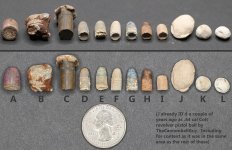Hi everyone, a couple of years ago I found what T'net member TheCannonBallGuy graciously ID'd for me as a Colt revolver .44 cal pistol ball. I've upgraded to a new detector since then and have found several more bullets/balls here in the back yard (Grimes county, TX... north of Houston ~ 90 miles) where the pistol ball came from. I'm wondering if anyone can provide any insight to any of the rest of them or point me to a good resource to research it up on my own (I've tried and failed to find such a thing). Just being nerdy and trying to paint a mental picture of who all's been tromping around here over the decades (and, of course, hoping one of them lost a bag of gold on my property, ha!).
Thanks for looking!
Jason













Thanks for looking!
Jason




 I struggle asking for help, so when I eventually do, I try to make it easier for those who are interested and hopefully demonstrate that I've put at least a little effort into it myself!
I struggle asking for help, so when I eventually do, I try to make it easier for those who are interested and hopefully demonstrate that I've put at least a little effort into it myself! 


